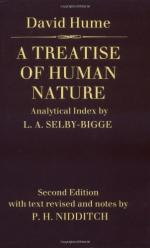A painter, who intended to represent a passion or emotion of any kind, would endeavour to get a sight of a person actuated by a like emotion, in order to enliven his ideas, and give them a force and vivacity superior to what is found in those, which are mere fictions of the imagination. The more recent this memory is, the clearer is the idea; and when after a long interval he would return to the contemplation of his object, he always finds its idea to be much decayed, if not wholly obliterated. We are frequently in doubt concerning the ideas of the memory, as they become very weak and feeble; and are at a loss to determine whether any image proceeds from the fancy or the memory, when it is not drawn in such lively colours as distinguish that latter faculty. I think, I remember such an event, says one; but am not sure. A long tract of time has almost worn it out of my memory, and leaves me uncertain whether or not it be the pure offspring of my fancy.
And as an idea of the memory, by losing its force and vivacity, may degenerate to such a degree, as to be taken for an idea of the imagination; so on the other hand an idea of the imagination may acquire such a force and vivacity, as to pass for an idea of the memory, and counterfeit its effects on the belief and judgment. This is noted in the case of liars; who by the frequent repetition of their lies, come at last to believe and remember them, as realities; custom and habit having in this case, as in many others, the same influence on the mind as nature, and infixing the idea with equal force and vigour.
Thus it appears, that the belief or assent, which always attends the memory and senses, is nothing but the vivacity of those perceptions they present; and that this alone distinguishes them from the imagination. To believe is in this case to feel an immediate impression of the senses, or a repetition of that impression in the memory. It is merely the force and liveliness of the perception, which constitutes the first act of the judgment, and lays the foundation of that reasoning, which we build upon it, when we trace the relation of cause and effect.
SECT. VI. OF THE INFERENCE FROM THE IMPRESSION TO THE IDEA.
It is easy to observe, that in tracing this relation, the inference we draw from cause to effect, is not derived merely from a survey of these particular objects, and from such a penetration into their essences as may discover the dependance of the one upon the other. There is no object, which implies the existence of any other if we consider these objects in themselves, and never look beyond the ideas which we form of them. Such an inference would amount to knowledge, and would imply the absolute contradiction and impossibility of conceiving any thing different. But as all distinct ideas are separable, it is evident there can be no impossibility of that kind. When we pass from a present impression to the idea of any object, we might possibly have separated the idea from the impression, and have substituted any other idea in its room.




